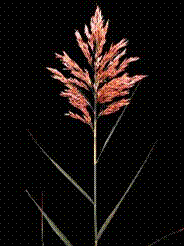|
"Your gateway to
understanding |
Common Reed
click for full size
• Very similar to the native common reed
• Non-native, European strain is highly invasive
• Dominates wet/marshy areas around Oneida Lake
Common reed is a grass species present across the United States and southern Canada. One strain is native to the United States, but an invasive strain was introduced to the US during the late 1800s, possibly in the solid ballast of ships. The origin of the invasive strain is unclear as it is widely distributed across Europe, Asia, Africa, and Australia. It consists of two subspecies; one is native and the other is from Europe. It is believed that the more aggressive, European reed is largely responsible for the early 20th century range expansion of this plant. The invasive subspecies is now present in every state across the US.
Common reed has caused damage to ecosystems from coast to coast. The major negative impact common reed has had is that it forms dense monocultures that out compete and replace mixed native wetland plant communities. This changes the way the ecosystem functions and negatively affects native wildlife. Human activities (change in land use patterns, increased disturbances, urbanization, etc.) are thought to have facilitated the expansion of common reed in the U.S.
Common reed can grow up to 15 feet tall. Leaves are 8-16 inches long and about one inch wide. Flowers develop by mid summer and are arranged in tawny spikelets with many tufts of silky hair. Common reed can reproduce by seed, but vegetative spread using below-ground rhizomes is more prevalent. Dense stands of Phragmites are common in wet, marshy habitats throughout the Oneida Lake watershed.
To learn more about Common Reed ...

